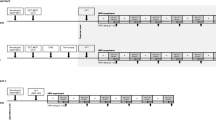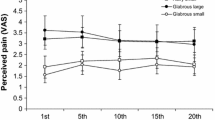Abstract
Unmyelinated cutaneous mechano-heat fibers (CMH) in the peroneal nerve of healthy human volunteers were studied by means of a “marking” technique which allows stable recordings from identified single units over extended periods. Mechanoreceptive field sizes were 105±13 mm2 in 25 units. These large receptive fields indicate extensive terminal branching of C fibers in the skin of foot and lower leg. Sensitization of CMHs was tested by assessment of thresholds for mechanical (von Frey hair) and heat stimuli before and after topical application of mustard oil (allyl isothiocyanate) and capsaicin (8-methyl-N-vanillyl-6-noneamide). While in a group of 14 CMHs the entire receptive field was treated with these irritant substances, in another group of 11 CMH units only parts of the receptive field were treated to check for signs of spreading sensitization through axon collaterals. Mustard oil application did not change mechanical thresholds, regardless of whether parts of or complete receptive fields were treated. However, mean heat thresholds dropped by 5.6° C to 36.5±1.5°C in completely treated receptive fields and by 5.7° C to 37.3±3.4° C in treated parts of receptive fields (“primary sensitization”). In contrast, heat thresholds in the non-treated parts did not change significantly (42.1±3.4° C vs 41.2±3.9° C), i.e. “secondary sensitization” to heat was lacking. The absence of primary sensitization to probing with von Frey hairs indicates that sensitization of insensitive C fibers and recruitment of insensitive axon collaterals may be more important for mechanical hyperalgesia than sensitization of conventional CMH units — apart from the contribution of central mechanisms. The lack of spread of sensitization to untreated parts of the receptive fields o CMHs (“secondary sensitization”) indicates that this fiber group is probably not involved in any form of secondary hyperalgesia to heating.
Similar content being viewed by others
References
Adriaensen H, Gybels J, Handwerker HO, Van Hees J (1983) Response properties of thin myelinated (A-delta) fibers in human skin nerves. J Neurophysiol 49:111–122
Baumann TK, Simone DA, Shain CN, LaMotte RH (1991) Neurogenic hyperalgesia: the search for the primary cutaneous afferent fibers that contribute to capsaicin-induced pain and hyperalgesia. J Neurophysiol 66:212–227
Beck PW, Handwerker HO, Zimmermann M (1974) Nervous outflow from the cat's foot during noxious radiant heat stimulation. Brain Res 67:373–386
Culp WJ, Ochoa JL, Cline M, Dotson R (1989) Heat and mechanical hyperalgesia induced by capsaicin: cross modality threshold modulation in human C nociceptors. Brain 112:1317–1331
Fitzgerald M (1979) The spread of sensitization of polymodal nociceptors in the rabbit from nearby injury and by antidromic nerve stimulation. J Physiol (Lond) 297:207–216
Forster C, Handwerker HO (1990) Automatic classification and analysis of microneurographic spike data using a PC/AT. J Neurosci Methods 31:109–118
Hallin RG, Torebjörk HE (1973) Electrical induced A and C fibre responses in intact human skin nerves. Exp Brain Res 16:309–320
Handwerker HO, Reeh PW (1992) Nociceptors: chemosensitivity and sensitization by chemical agents. In: Willis WD (eds) Hyperalgesia and allodynia. (Bristol-Myers Squibb Symposium on Pain Research) Raven Press, New York, pp 107–116
Handwerker HO, Forster C, Kirchhoff C (1991) Discharge patterns of human C-fibers induced by itching and burning stimuli. J Neurophysiol 65:307–315
Handwerker HO, Schmelz M, Schmidt R, Ringkamp M, Torebjörk HE (1994) Heat sensitization of receptive fields in human skin C nociceptors. Soc Neurosci Abstr 20:763
Hardy JD, Wolff HG, Goodell H (1952) Experimental evidence on the nature of cutaneous hyperalgesia. J Clin Invest 29:115–140
Jancso N (1960) Role of the nerve terminals in the mechanism of inflammatory reactions. Bull Millard Fillmore Hosp, Buffalo, NY 7:53–77
Jancso N, Jancso Gabor A, Szolcsanyi J (1967) Direct evidence for neurogenic inflammation and its prevention by denervation and by pretreatment with capsaicin. Br J Pharmacol 31:138–151
Jancso N, Jancso Gabor A, Szolcsanyi J (1968) The role of sensory nerve endings in neurogenic inflammation induced in human skin and in the eye and paw of the rat. Br J Pharmacol 32:32–41
Kilo S, Schmelz M, Koltzenburg M, Handwerker HO (1994) Different patterns of hyperalgesia induced by experimental inflammations in human skin. Brain 117:385–396
Kocher L, Anton F, Reeh PW, Handwerker HO (1987) The effect of carrageenan-induced inflammation on the sensitivity of unmyelinated skin nociceptors in the rat. Pain 29:363–373
Koltzenburg M, Lundberg LER, Torebjörk HE (1992) Dynamic and static components of mechanical hyperalgesia in human hairy skin. Pain 51:207–219
LaMotte RH, Shain CN, Simone DA, Tsai EF (1991) Neurogenic hyperalgesia: psychophysical studies of underlying mechanisms. J Neurophysiol 66:190–211
LaMotte RH, Lundberg LER, Torebjörk HE (1992) Pain, hyperalgesia and activity in nociceptive-C units in humans after intradermal injection of capsaicin. J Physiol (Lond) 448:749–764
Lewis T (1935) Experiments relating to cutaneous hyperalgesia and its spread through somatic nerves. Clin Sci 2:373–423
Lisney SJW, Bharali LAM (1989) The axon reflex: an outdated idea or a valid hypothesis? New Physiol Sci 4:45–48
Lynn B (1990) Capsaicin: actions on nociceptive C-fibers and therapeutic potential. Pain 41:61–69
Lynn B, Carpenter SE (1982) Primary afferent units from the hairy skin of the rat hind limb. Brain Res 238:29–43
Meyer RA, Campbell JN, Raja SN (1988) Antidromic nerve stimulation does not sensitize unmyelinated nociceptors to heat. Brain Res 441:168–172
Ochoa JL, Yarnitsky D (1993) Mechanical hyperalgesias in neuropathic pain patients: dynamic and static subtypes. Ann Neurol 33:465–472
Reeh PW, Kocher L, Jung S (1986) Does neurogenic inflammation alter sensitivity of unmyelinated nociceptors in the rat? Brain Res 384:42–50
Schmelz M, Schmidt R, Ringkamp M, Handwerker HO, Torebjörk HE (1994) Sensitization of insensitive branches of C nociceptors in human skin. J Physiol (Lond) 480:389–394
Schmelz M, Forster C, Schmidt R, Ringkamp M, Handwerker HO, Torebjörk HE (1995) Delayed responses to electrical stimuli reflect C-fiber responsiveness in human microneurography. Exp Brain Res 104:331–336
Schmidt R, Schmelz M, Forster C, Ringkamp M, Torebjörk HE, Handwerker HO (1995) Novel classes of responsive and unresponsive C nociceptors in human skin. J Neurosci 15:333–341
Szolcsanyi J (1988) Antidromic vasodilatation and neurogenic inflammation. Agents Actions 23:4–11
Szolcsanyi J, Anton F, Reeh PW, Handwerker HO (1988) Selective excitation by capsaicin of mechano-heat sensitive nociceptors in rat skin. Brain Res 446:262–268
Thalhammer JG, LaMotte RH (1982) Spatial properties of nociceptor sensitization following heat injury of the skin. Brain Res 231:257–265
Torebjörk HE (1974) Afferent C units responding to mechanical, thermal and chemical stimuli in human non-glabrous skin. Acta Physiol Scand 92:374–390
Torebjörk HE, Hallin RG (1974) Responses in human A and C fibres to repeated electrical intradermal stimulation. J Neurol Neurosurg Psychiatry 37:653–664
Torebjörk HE, Lundberg LER, LaMotte RH (1992) Central changes in processing of mechanoreceptive input in capsaicin-induced secondary hyperalgesia in humans. J Physiol (Lond) 448:765–780
Vallbo AB, Hagbarth KE, Torebjörk HE, Wallin BG (1979) Somatosensory, proprioceptive and sympathetic activity in human peripheral nerves. Physiol Rev 59:919–957
Van Hees J, Gybels J (1981) C nociceptor activity in human nerve during painful and non-painful skin stimulation. J Neurol Neurosurg Psychiatry 44:600–607
Weihe E, Hartschuh W (1988) Multiple peptides in cutaneous nerves: regulators under physiological conditions and a pathogenetic role in skin disease? Semin Dermatol 7:284–300
Author information
Authors and Affiliations
Rights and permissions
About this article
Cite this article
Schmelz, M., Schmidt, R., Ringkamp, M. et al. Limitation of sensitization to injured parts of receptive fields in human skin C-nociceptors. Exp Brain Res 109, 141–147 (1996). https://doi.org/10.1007/BF00228635
Received:
Accepted:
Issue Date:
DOI: https://doi.org/10.1007/BF00228635




